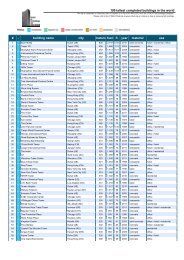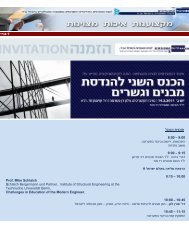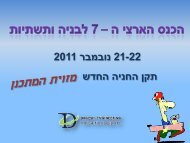צמנט רגיל צמנט : מסמך זה הוא הצעה בלבד מכון התקנים הישראלי
צמנט רגיל צמנט : מסמך זה הוא הצעה בלבד מכון התקנים הישראלי
צמנט רגיל צמנט : מסמך זה הוא הצעה בלבד מכון התקנים הישראלי
You also want an ePaper? Increase the reach of your titles
YUMPU automatically turns print PDFs into web optimized ePapers that Google loves.
ועדה 10601EN 197-1:2011 (E)Minor additional constituents, after appropriate preparation and on account of their particle size distribution, improve thephysical properties of the cement (such as workability or water retention). They can be inert or have slightly hydraulic,latent hydraulic or pozzolanic properties. However, no requirements are set for them in this respect.Minor additional constituents shall be correctly prepared, i.e. selected, homogenised, dried and comminuted dependingon their state of production or delivery. They shall not increase the water demand of the cement appreciably, impair theresistance of the concrete or mortar to deterioration in any way or reduce the corrosion protection of the reinforcement.NOTEInformation on the minor additional constituents in the cement should be available from the manufacturer on request.5.4 Calcium sulfateCalcium sulfate is added to the other constituents of cement during its manufacture to control setting.Calcium sulfate can be gypsum (calcium sulfate dihydrate, CaSO 4 ⋅ 2H 2 O), hemihydrate (CaSO 4 ⋅ ½H 2 O), or anhydrite(anhydrous calcium sulfate, CaSO 4 ) or any mixture of them. Gypsum and anhydrite are found naturally. Calcium sulfateis also available as a by-product of certain industrial processes.5.5 AdditivesAdditives for the purpose of EN 197-1 are constituents not covered in 5.2 to 5.4 which are added to improve themanufacture or the properties of the cement.The total quantity of additives shall not exceed 1,0 % by mass of the cement (except for pigments). The quantity oforganic additives on a dry basis shall not exceed 0,2 % by mass of the cement. A higher quantity may be incorporatedin cements provided that the maximum quantity, in %, is declared on the packaging and/or the delivery note.These additives shall not promote corrosion of the reinforcement or impair the properties of the cement or of theconcrete or mortar made from the cement.When admixtures for concrete, mortar or grouts conforming to the EN 934 series are used in cement the standardnotation of the admixture shall be declared on bags or delivery documents.6 Composition and notation6.1 Composition and notation of common cementsThe products in the family of common cements, covered by EN 197-1, and their notation are given in Table 1. They aregrouped into five main cement types as follows:⎯ CEM I Portland cement,⎯CEM II Portland-composite cement,⎯ CEM III Blast furnace cement,⎯⎯CEM IV Pozzolanic cement,CEM V Composite cement.The composition of each of the products in the family of common cements shall be in accordance with Table 1.NOTE For clarity in definition, the requirements for the composition refer to the sum of all main and minor additionalconstituents. The final cement is to be understood as the main and minor additional constituents plus the necessary calcium sulfate(see 5.4) and any additives (see 5.5).14
















